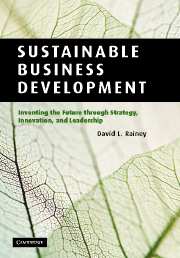Book contents
- Frontmatter
- Contents
- List of figures
- List of tables
- List of boxes
- List of abbreviations
- Acknowledgments
- Introduction
- Part I Enterprise thinking, the driving forces of change, and leadership
- 1 Sustainable business development: overview and guiding principles
- 2 Enterprise thinking and the strategic logic of strategic business development
- 3 Crafting sustainable business strategies and solutions
- 4 The driving forces of social-, economic-, and environmental-related change
- 5 The driving forces of markets and stakeholders' connectedness
- 6 Crafting a sustainable enterprise through leadership and capabilities
- Part II Innovation management, life cycle considerations, and insights
- Glossary
- Select bibliography
- Index
- References
6 - Crafting a sustainable enterprise through leadership and capabilities
from Part I - Enterprise thinking, the driving forces of change, and leadership
Published online by Cambridge University Press: 04 December 2009
- Frontmatter
- Contents
- List of figures
- List of tables
- List of boxes
- List of abbreviations
- Acknowledgments
- Introduction
- Part I Enterprise thinking, the driving forces of change, and leadership
- 1 Sustainable business development: overview and guiding principles
- 2 Enterprise thinking and the strategic logic of strategic business development
- 3 Crafting sustainable business strategies and solutions
- 4 The driving forces of social-, economic-, and environmental-related change
- 5 The driving forces of markets and stakeholders' connectedness
- 6 Crafting a sustainable enterprise through leadership and capabilities
- Part II Innovation management, life cycle considerations, and insights
- Glossary
- Select bibliography
- Index
- References
Summary
Introduction
Executive leadership and management commitment are two critical requirements for leading change, achieving exceptional performance, and sustaining success. Management must lead at all levels; executives and senior management must create a vision for the future, position the enterprise to realize that vision, and inspire people to transform the corporation's existing capabilities into world-class competencies. Leadership must engage people across the enterprise, imbue an awareness of and commitment to the principles and objectives of SBD, and build the knowledge, capabilities, and actions necessary to support the transition or transformation to a richer reality. Leadership accomplishes all of this by discovering opportunities for growth, development, and improvements, and by mitigating defects, burdens, and impacts.
Leadership of a corporation includes the executives, corporate management, senior management of groups, business units, and subsidiaries, and operational management at the product delivery level. Executives are usually officers of the corporation. Executives and other senior corporate management are responsible for setting the strategic direction, policies, principles, and values and for assuring governance, reporting, and ethical behaviors. Moreover, they have the overall responsibility for ensuring that the corporation meets its objectives, performance criteria, and social responsibility goals.
A corporation's vision determines the direction, strategies, systems, programs, and processes of the organization and, therefore, the potential for achieving sustainable success. For this reason, executive leadership is at the pinnacle of leadership responsibility for SBD. Executives fulfill a dual role, articulating this all-important vision as corporate officers, while also ensuring that the enterprise meets its social, economic, environmental, and business obligations to customers, stakeholders, and society.
- Type
- Chapter
- Information
- Sustainable Business DevelopmentInventing the Future Through Strategy, Innovation, and Leadership, pp. 336 - 380Publisher: Cambridge University PressPrint publication year: 2006



